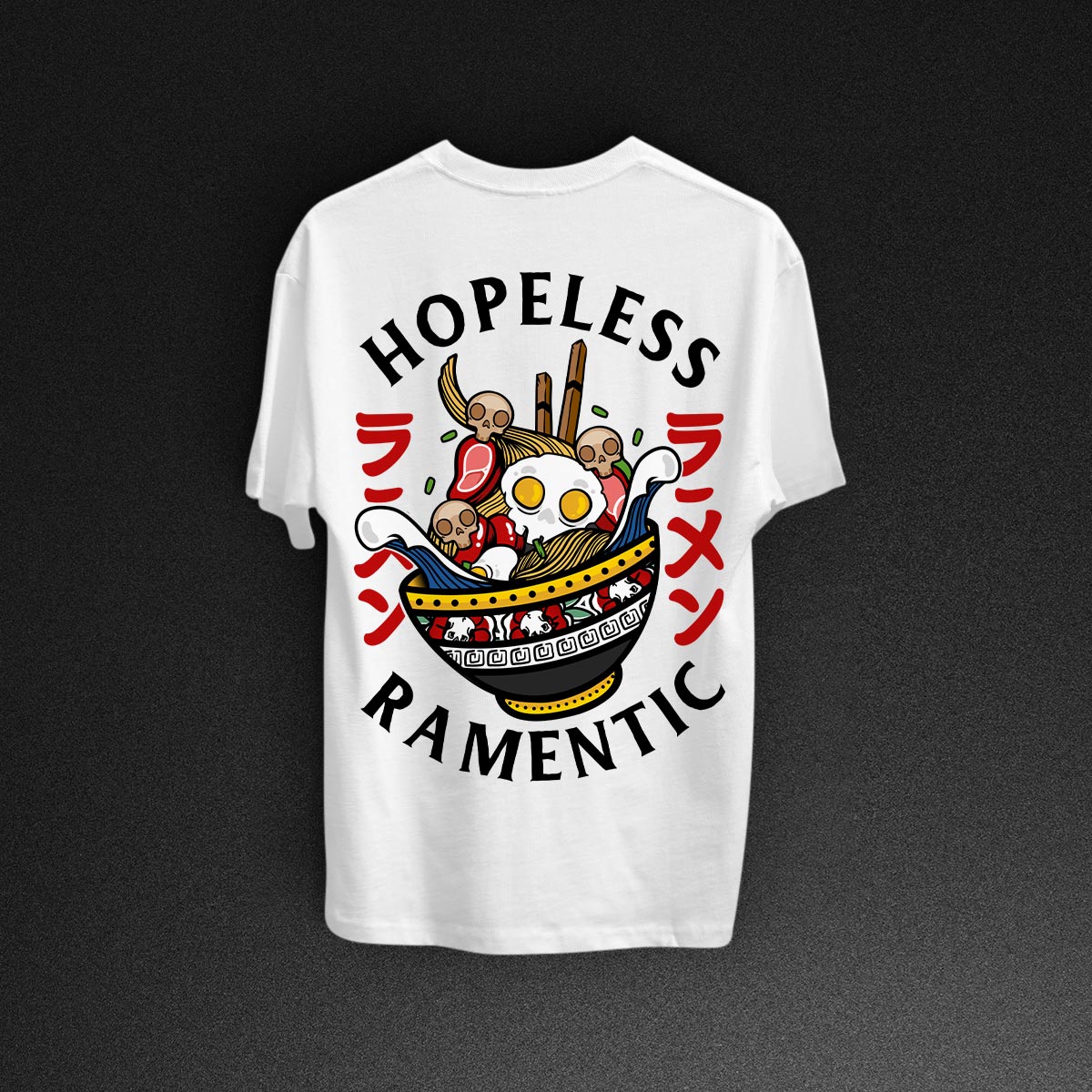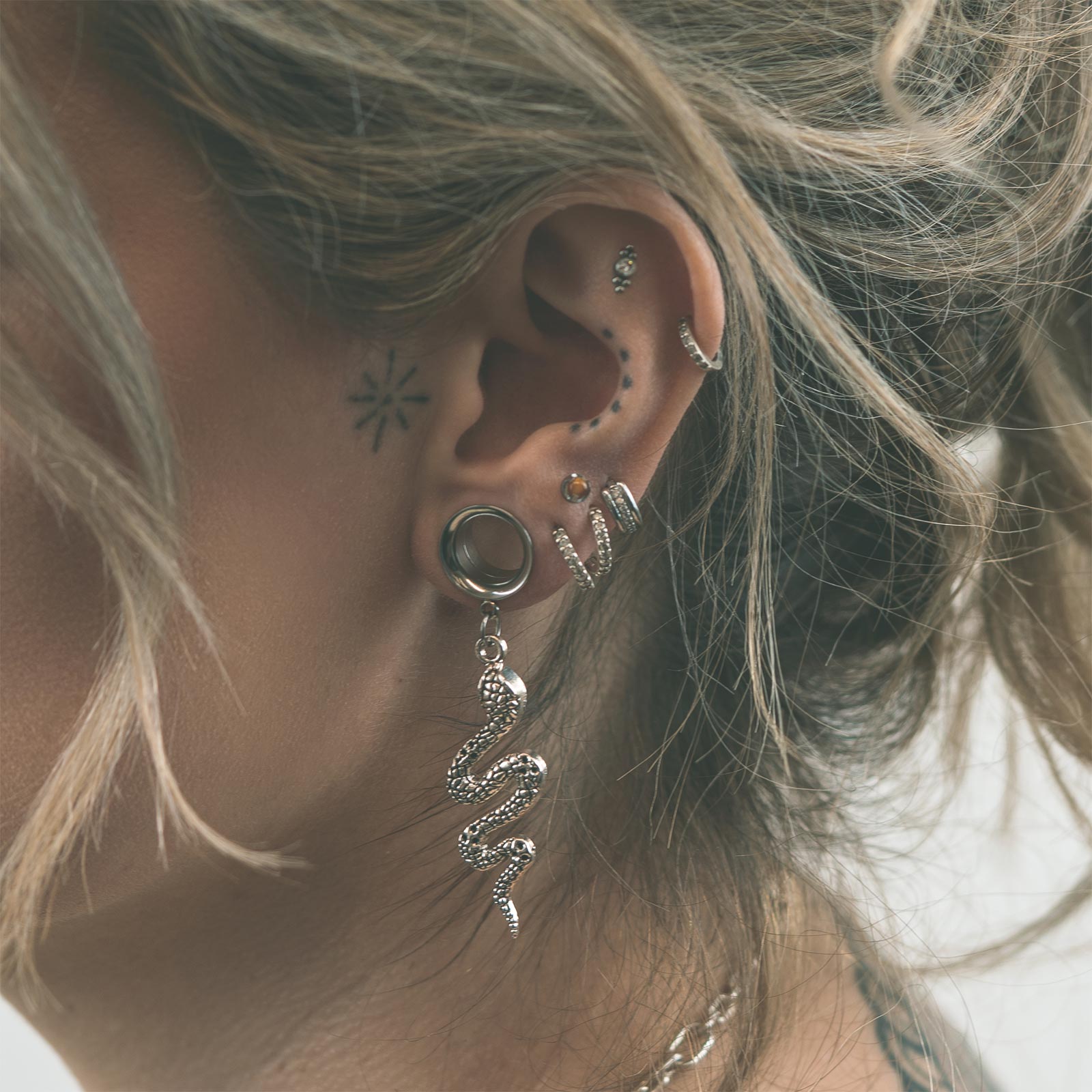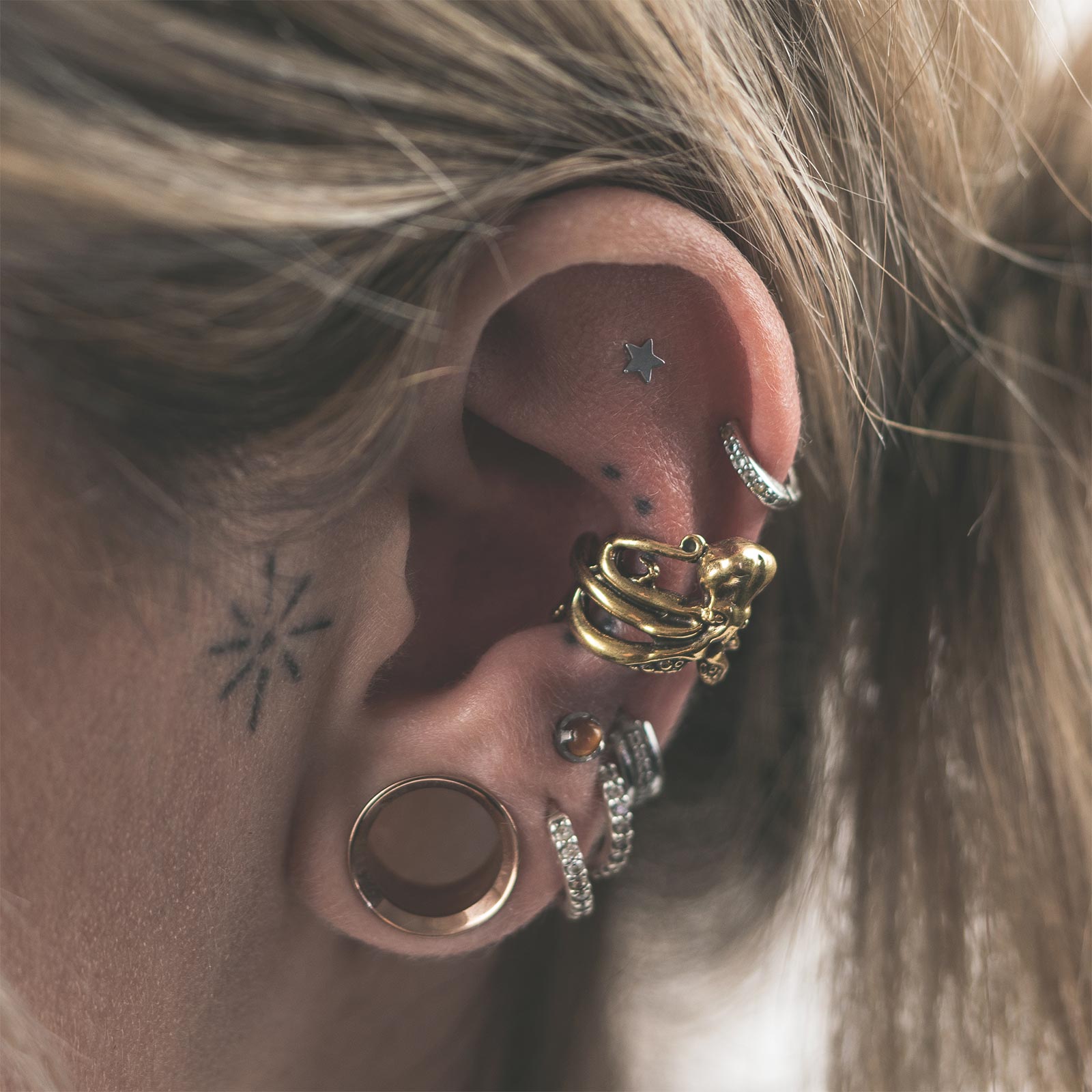"If you're thinking about ear stretching, remember you're not just following a trend. By comparison, you’re following in the footsteps of a long lineage of rebels, warriors, and self-expressionists spanning the globe and the ages."
Under the impression ear stretching is a recent thing? Telegraph journalist Elliott Howarth felt the same when he decided it was for him. “I spotted what I thought of as ‘my sort’ of people, people with giant holes through their ears who seemed to skulk around in a cool sort of fashion I tried to copy”, he said in his Look at those lugholes! Article.
“It turned out that what I thought was a new trend had been around for many thousands of years and that I was hardly an innovator of this form of ‘body modification’.”
Yes, ear gauges have a unique history steeped in rebellion and ritual. In fact, ear lobe stretching has been the punk rock of body modification for millennia. That's right, people were pushing the boundaries of ear stretching sizes across continents and centuries long before safety pins through noses were a thing.
So, buckle up and get ready for a sometimes crazy but always compelling ride through ear stretching history.
Discussed In This Post
The Dawn of Ear Stretching – Meet Ötzi the OG Gauger
Ever heard of the man who became known as Ötzi? He was discovered frozen in the Italian Alps in 1991 and he’s reckoned to be the original ear gauger. More precisely, this 5,300-year-old mummy had respectable 8mm ear gauge sizes.
Now, ear stretching is prized for its aesthetic and as a means of self-expression. But, Ötzi's discovery threw the doors open to a world where body modification, especially ear lobe stretching, held many different meanings to different civilizations.
Ear Stretching Traditions through Time and Flesh
Ear gauges are rooted in diverse ancient cultures around the globe. For example, ear lobe stretching was a common practice for the Pharaohs of Egypt, the Mayans and Aztecs in the Americas, and various other tribes across Asia and Africa.
Here are some of the most notable people and places that have contributed to introducing and furthering the ear stretching phenomenon:
Asia's Gods
Eastern deities like Gautama Buddha used heavy jewellery to increase ear stretching sizes as far back as 563BC! As legend has it, his ear gauge sizes represented his vast wealth. But they came to symbolise his journey to enlightenment, remaining in place after he renounced his riches.
He opted for a more frugal lifestyle. But in doing so, he earned something money can’t buy – his place in history. And he remains immortalised in the ear stretching community to this day, with ear plugs and tunnels bearing his iconic image.

Borneo's Dayaks
The Dayak in the wilds of Borneo focused on long ear stretching sizes rather than wide ones. They used heavy brass jewellery to achieve the desired effect, with women often having ear gauges down to their shoulders, while the men opted for shorter stretches.
Perhaps a bit OTT for the 2020s. But their legacy lives on in some of the stunning brass ear tunnels and plugs on the market today. And better still that current examples are free of lead, nickel, and cadmium, making the Dayak’s beloved brass perfectly safe for fully healed stretched lobes.

Egypt's Pharaohs
Tutankhamun is perhaps the most famous example of ancient rockstars slaying it with ear gauges. His golden death mask reveals his larger ear stretching sizes at around 10mm (00g), which is generally thought of as ‘the point of no return’ by today’s standards.
And this wasn't exclusive to royalty. Everyday Egyptians also wore ear flesh tunnels and plugs. Back then, it was mainstream rather than an alternative fashion statement.

But, what about why ear stretching started in the first place? And not only started, but endured through the centuries?
Embodying Spirituality and Status with Ear Stretching Sizes
We’ve already covered how Buddha initially wore his ear gauge sizes as a physical representation of his wealth. And he wasn’t alone in sporting stretches for this reason. In addition to Buddha, there are common themes of spirituality and social status throughout the history of ear lobe stretching, like:
- Mayan Spirituality - The Mayans used alabaster, ceramic, gold, and jade ear plugs and tunnels as far back as 3000 BC, believing ear gauges invited spirits into the bodies.
- Aztec Status Symbols - The Aztecs also used ear tunnels and plugs. But their purpose was materialistic rather than mystic. Furthermore, they taught their children early on about the importance of ambition. Young ears were pierced with string, ready to be replaced with ear flesh tunnels and plugs as a rite of passage into adulthood – and hopefully prosperity.
Imagine now, poking string through your piercings! It's one of many examples of how times – and techniques – have evolved over the years.
Ear Stretching Then and Now
The ancients had to get creative with what nature gave them, back in the days before modern tools and techniques. But you can see how their primitive materials and methods aren’t actually that different from today:
Tools of the trade:
Then – Bones, plant roots, thorns, needles, shards of tusk.
Now – Ear stretching kits, tapers, premium ear stretching tape.
Health and safety:
Then – Forced dead stretching with natural oils to achieve bigger ear stretching sizes in the least time.
Now – Widespread use of sterilised tools and professional ear stretching kits, with a focus on gradually increasing sizes to avoid damaging the tissue for an enjoyable pain-free experience.
Materials used for ear plugs and tunnels:
Then - Bone, gold, stone, wood
Now - Today, you’re spoilt for choice by tons of safe, biocompatible options such as:
- Stainless steel - Ideal for initial stretching, thanks to its smooth surface and low reactivity levels
- Titanium - The failsafe choice if you’ve got sensitive, irritation-prone skin
- Silicone - Lightweight and flexible, perfect for healed ear gauges
- Glass - Non-porous and easy to clean. A great choice for many good reasons, including the sheer variety of options, colourways and looks you can create.
Aftercare to minimise infection risks:
Then - Herbal salves and oils
Now – LobeLove™ Organic Golden Jojoba Oil, LobeLove™ Premium Ear Stretching Balm , LobeLove™ Professional Saline Piercing Spray
Dead Stretching – From Random to Reliable
Besides the materials and tools, there are also similarities – and divergences over time – in technique. For instance, dead stretching offers clear evidence.
In olden times, it meant forcing jewellery in for enlarged ear gauges. Despite natural oils being used, it was a painful and risky business, often leading to scar tissue and permanent damage. A far cry from today’s slow and steady approach.
Thankfully, most of the nasty stuff has been left behind, resigned to history where it belongs. But it hasn’t stopped some cultures holding on tight to their traditions.
Keeping Ear Lobe Stretching Alive

In the western world, people who are bitten by the ear stretching bug are usually drawn to it as a way of expressing individuality. Elsewhere, ear lobe stretching traditions continue among tribes from the African jungles to the Asian pagodas. Each upholds their own unique practices, such as:
- Fulani (West Africa) - Unlike some tribes, the Fulani prefer conservative ear stretching sizes. They wear large gold earrings in leaf designs up to five inches long, known as kwottone kanye. These eye-catching hoops symbolise wealth and status, going right back to the origins of ear gauges.
- Maasai (Kenya and Tanzania) – The Maasai people stretch their ears with heavy jewellery made from natural materials like bone and stone, often with colourful beads and ear weights. Whereas today’s fantastic selection of brass, stone, and opalite ear weights are designed to be worn for adornment purposes only, not for stretching.
- Mursi (Ethiopia) – Even if you’ve never heard of the Mursi women, you’ve probably seen them in the media. They’re best known for their large wooden lip plates. But they’re also keen ear stretchers. Initiation begins in adolescence, using wooden plugs to gradually increase ear gauge sizes. It’s notable wooden ear plugs and tunnels aren’t recommended for fresh stretches in the western world, because wood is porous and consequently bacteria prone. Although it’s fine for healed ear gauges.
- Lahu and Karen-Padaung (Myanmar and Thailand) - These tribes believe ears are sacred and should be adorned with as much jewellery as possible. For this purpose, ear stretching has been a longstanding cultural tradition.
Besides looking back, ear lobe stretching extends into popular culture. And you could say it’s as much of a tribal thing as it’s always been for the ancient African and Asian clans. There’s just a different dynamic at play.
Stretching into the Celebrity Spotlight
Now, ear gauges have fans among the rich and famous, with celebrity endorsement bringing ear stretching further into the mainstream.
Stars of the screen, music and fashion worlds who wear ear tunnels and plugs include:
- Actress Scarlett Johansson
- Singer songwriter Kehlani
- Rapper and record producer T-Pain
- Stylist, fashion designer, and TV presenter Gok Wan – In fact, Wan was photographed wearing fake ear gauges, representing a massive nod from the popular fashionista
- Singer Adam Lambert
- Hip hop artiste, songwriter, and record executive Lil’ Wayne
- Blink-182 drummer Travis Barker
Busting Common Myths and Avoiding Risks

Like any form of body modification, ear stretching comes with its share of folklore and exposure to risk. Here are the most common ones:
- Myth - Bigger ear gauge sizes are always better. False! Truth is, it's your call, your personal preference, and, of course, safe practices.
- Risks - Tears, blowouts, uneven stretching, allergies and infections are potential hazards. But they shouldn’t scaremonger or deter you. You can mitigate these risks with proper care and gradual ear lobe stretching.
Ear Stretching Past, Present, and Future

As you can see, ear stretching bridges the past with the present, from ancient tribes, to taboo practice, to a ‘left of centre’ but increasingly accepted form of self-expression as society shifts. It was once a symbol of status and spirituality. But fast forward to the present day, ear flesh tunnels and plugs are now celebrated for their aesthetic appeal and individuality.
What about predictions for the future?
Moving forward, ear gauges are set to continue being a vibrant part of body modification culture and a powerful form of self-expression.
Additionally, it's easier and safer than ever to achieve gorgeously stretched ear gauge sizes, as materials and techniques keep getting more advanced.
So, if you're thinking about ear stretching, remember you're not just following a trend. By comparison, you’re following in the footsteps of a long lineage of rebels, warriors, and self-expressionists spanning the globe and the ages.
Embrace it. Enjoy it. And wear your history with pride.
Want to join the stretched ear club, or move up to larger ear stretching sizes? At Stretch It Body Jewellery, we've got everything you need to master (or mistress) a tradition spanning centuries and cultures.
Click here to check out our killer selection of kits, ear tunnels and plugs. It's time to unleash your inner earlobe revolutionary and make your mark on this ancient art form. Let Stretch It Body Jewellery and history inspire your unique ear stretching journey.
Subscribe To Our Awesome Mailer
No spam. Just discounts, exclusive promotions and ear stretching tips & tricks you won't want to miss.




















